Many traditional spring-flowering bulbs perform beautifully in California and other mild climates, as shown here in the glorious annual display on Daffodil Hill in California's Gold Country. But lack of enough winter chill puts a damper on certain other bulbs — and also creates opportunities to grow some very special bulbs. Here are tips for choosing and growing bulbs if you live in a mild climate.
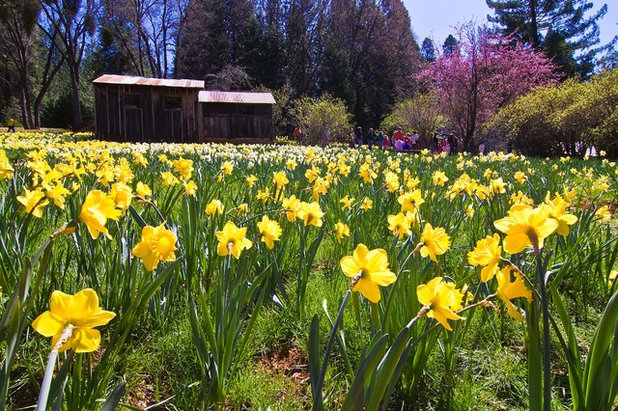
ca.myphotoscout.com
7 Rules for Planting Bulbs in Mild ClimatesHere are some things to keep in mind if you garden in a climate with relatively mild winters.
- Order early, plant late. For the best selection, shop for bulbs as soon as they arrrive in fall. But don't feel you have to rush them into ground that is still warm. Mid to late October and November are fine for planting, and even early December is not too late.
- Chill out. Mild winters don't provide certain bulb species with enough cold weather. To compensate, chill tulip and hyacinth bulbs for six weeks before planting; store them in a paper bag in the refrigerator.
- Think deep. Follow the recommended planting depths for all types of bulbs. Better to plant too deep than too shallow.
- Multiply. Most bulbs look best when planted in groups of three or more — drifts of 50 to 100 if your space and budget allow. Or plant a dozen or two in a pot.
- Feed generously. Enhance bulb performance by fertilizing at planting time. It's simplest to sprinkle bulb fertilizer into the planting holes or mix it into the planting bed.
- Water thoughtfully. Keep the soil moist through winter if rains don't do the job.
- Don't expect longevity. Many bulbs don't offer more than one outstanding bloom show in mild climates. In particular, tulips and hyacinths are one-and-dones; after bloom time dig up the bulbs and discard or give them away.
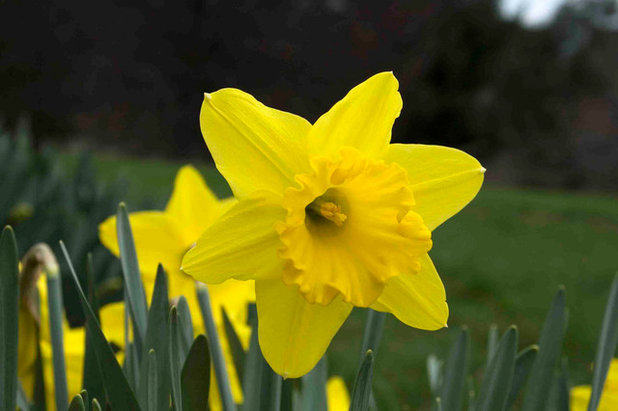
The New York Botanical Garden
Daffodils (narcissus).
The classic symbols of early spring are easy to grow in most mild climates, and they can come back year after year when left in the ground. Plant in flowing drifts, spotted under trees, in borders between shrubs and perennials, or in pots. Classic yellow types that do well in mild climates include 'Dutch Master' and 'February Gold'. 'Gigantic Star' is shown here.
USDA zones: 3 to 9 (find your zone)
Light requirement: Full sun or light shade
Mature size: 6 to 24 inches high
Bloom time: Generally late winter through early spring; as early as midwinter in California and other mild climates
Planting tips for mild climates: Plant daffodils in well-cultivated soil in mid to late fall (early December is still OK). Bury bulbs at a depth that is two or three times their height, 6 to 8 inches apart. Water the bulbs after planting, and keep the soil moist through winter if rains don't do the job. After bloom time cut off faded flowers. Allow the leaves to dry (or wait at least six weeks) before removing them. You can leave the bulbs in the ground (avoid heavy summer watering) or dig and store them for next season.
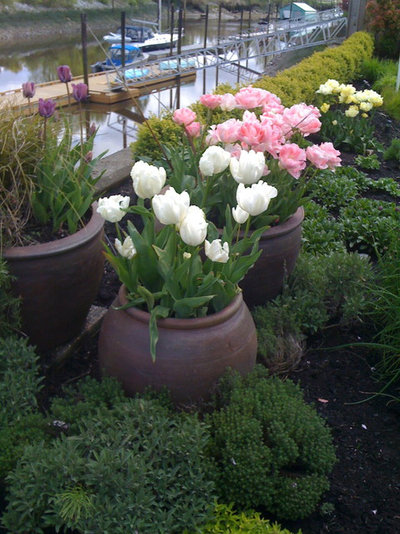
Glenna Partridge Garden Design
Tulips (tulipa). The most traditional tulips are Dutch hybrids, and they're great in formal gardens, beds and containers. Or try some of the smaller species especially suited to mild climates, such as
Tulipa clusiana chrysantha (star-shaped, yellow and rose).
USDA zones: 4 to 10; best in 4 to 6
Light requirement: Full sun, or partial shade in hot climates
Mature size: Varies greatly among many species and cultivars
Bloom time: Early to late spring, depending on climate and variety
Planting tips for mild climates: Provide extra chill by storing the bulbs in your refrigerator's vegetable crisper for six weeks before planting. Wait until November or early December to plant them. Plant bulbs at a depth that is three times their width, 4 to 6 inches apart. After bloom time dig up the blooms and (sorry to say) discard them.
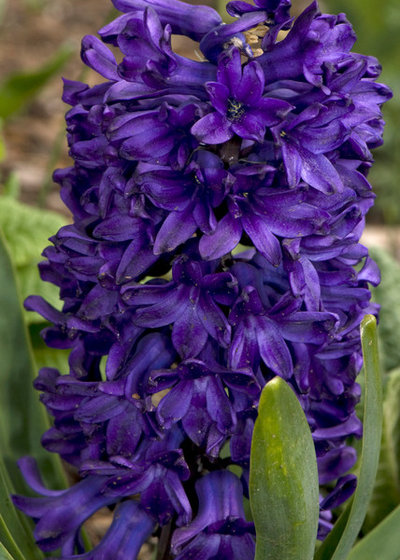
The New York Botanical Garden
Hyacinths (hyacinthus).
Dutch hybrids such as 'Peter Stuyvesant', shown, are plush and fragrant but last only one season in mild climates. Plant them where you can smell them — along a walk, in beds or in pots on a porch.
USDA zones: 5 to 9
Light requirement: Full sun or partial shade
Mature size: 6 to 14 inches high
Bloom time: Early to mid spring
Planting tips for mild climates: Buy big bulbs for big flowers. Before planting, store them in the refrigerator, as for tulips. Plant in mid to late fall. Bury bulbs 5 inches deep, 5 inches apart. After bloom time, treat them like tulips.
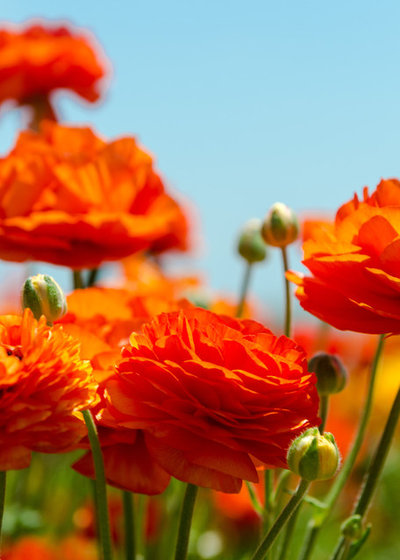
California Flowerbulb Company, Inc.
Ranunculus (ranuniculaceae). The growing fields of vivid ranunculus in bloom create a tourist magnet near San Diego. Tecolote hybrids — white, yellow, orange, red, pink — are longtime favorites, outstanding in borders or pots. In mild climates, plant them in fall for spring bloom; in cold-winter climates, plant them in spring.
USDA zones: 8 to 10 when planted in fall
Light requirement: Full sun
Mature size: Up to 2 feet high
Bloom time: Late winter or early spring
Planting tips for mild climates: Plant bulbs (actually tuberous roots) in fall in pots or well-cultivated ground. (Bigger bulbs produce more flowers.) Place the roots pointed down, 2 inches deep and 6 inches apart. Water and wait until leaves emerge before watering again unless the soil dries out. Protect seedlings from birds. You may need to lightly stake floppy plants. After bloom time cut off faded flowers, let plants dry, and dig and store roots — they may do well a second year.
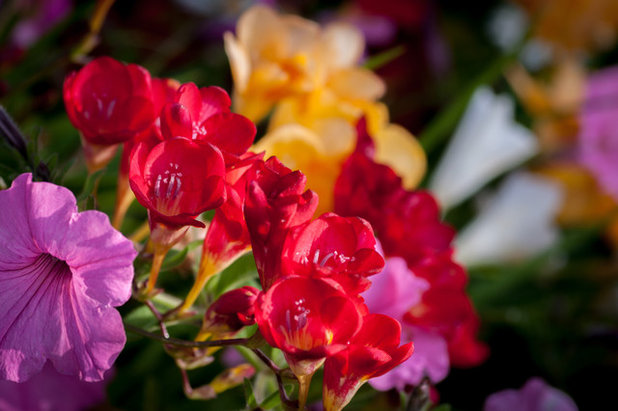
California Flowerbulb Company, Inc.
Freesia (iridaceae).
Known for their sweet fragrance as cut flowers, freesias bloom longer than most spring bulbs. White is the most common color; there's also yellow, orange, red, pink and blue. In mild climates to their liking, they can spread and naturalize.
USDA zones: 9 to 10
Light requirement: Full sun or partial shade
Mature size: 12 to 18 inches
Bloom time: Spring
Planting tips for mild climates: Plant corms in fall, 2 inches deep and 2 inches apart. After bloom time, when leaves have yellowed, dig and store the corms in a dry spot. Or leave the corms in the ground for blooms in following years.
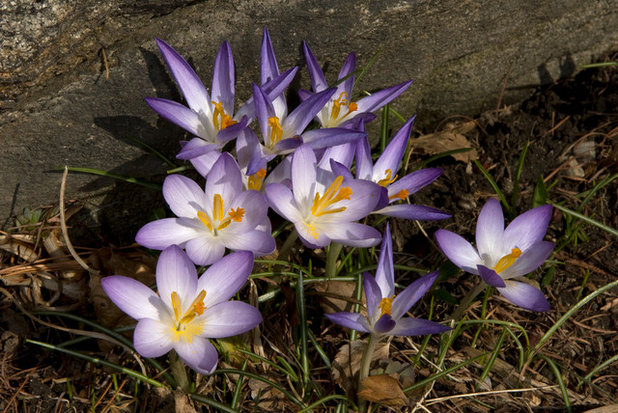
The New York Botanical Garden
Crocus (crocus). Pint-sized harbingers of spring, they're most meaningful when they poke up through snow, but they're still fun to grow in sunny winter climates. Squeeze the bulbs in between rocks, stepping stones or pavers. There are many species and cultivars. The most popular is
Crocus chrysanthus, in white, yellow, blue, purple and other colors. The plant shown here is
Crocus tommasinianus var.
pictus.
USDA zones: 3 to 9, depending on species
Light requirement: Full sun
Mature size: 2 inches high and up, depending on species
Bloom time: Early spring (some species bloom in fall)
Planting tips for mild climates: Plant the small bulbs (actually corms) in fall, 3 inches deep and 3 inches apart. After bloom time try leaving the bulbs in place — they may come back or may not.
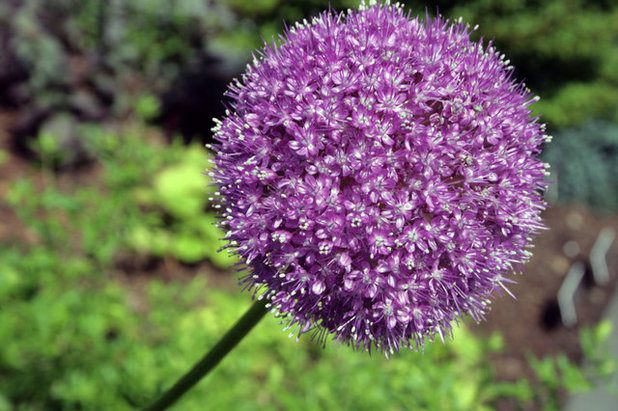
The New York Botanical Garden
Allium (liliaceae). This big group of plants includes onions, garlic and chives as well as many kinds of spring-blooming bulbs, some with flowers softball size or larger, such as
Allium giganteum, shown here. Just a few bulbs can put on quite a show.
USDA zones: 4 to 10, depending on species
Light requirement: Full sun
Mature size: 6 inches to 2 feet high and up, depending on species
Bloom time: Spring and summer
Planting tips for mild climates: Plant bulbs in fall, 3 inches deep and 6 to 8 inches apart. Place the bulbs with the pointy end facing up.





